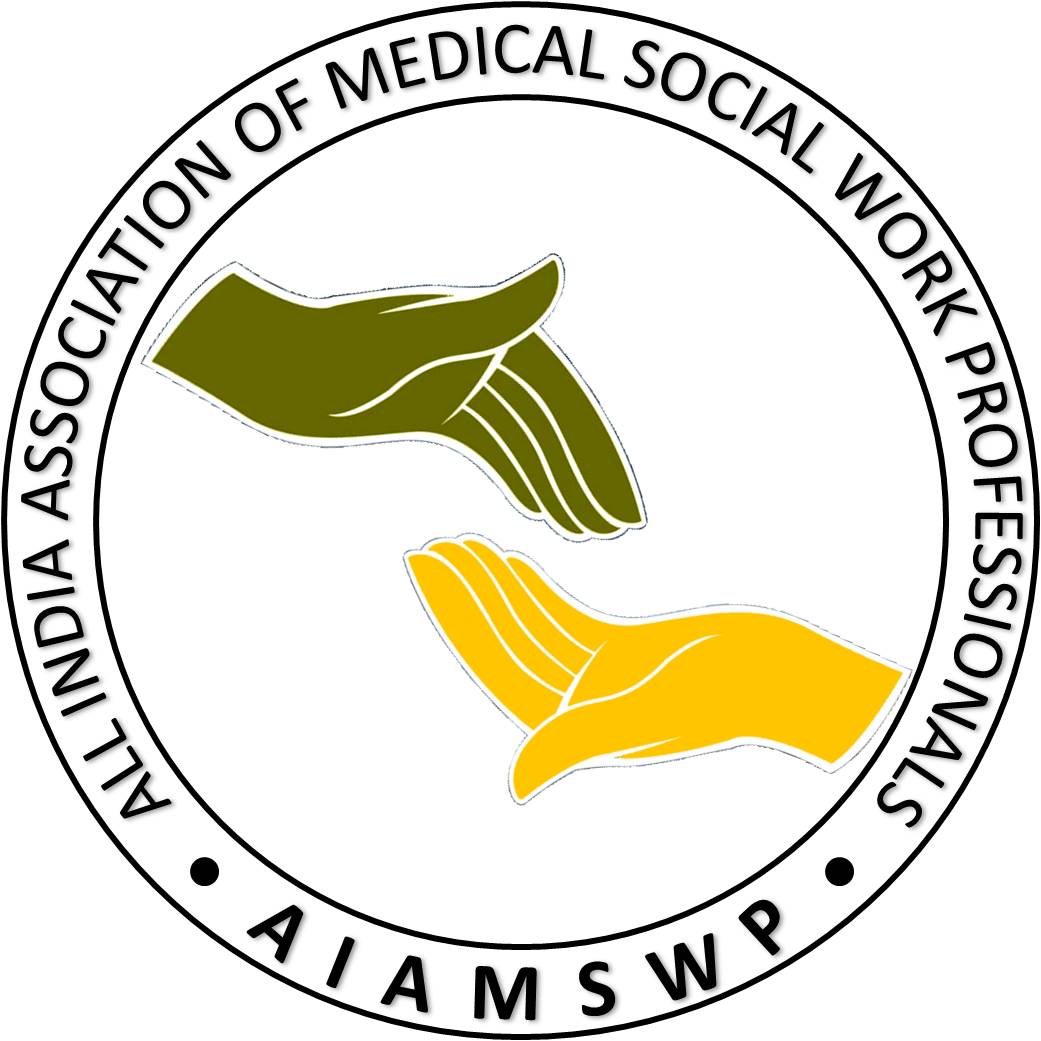Indian Journal of Health Social Work
(UGC Care List Journal)
Availability of Health Infrastructure and Accessibility to Health Services in the Urban Slums of Kolkata: A Contextual Exploration
Shreya Chatterjee1 & Subhashree Sanyal2
1Research Scholar, Department of Social Work, Visva-Bharati University, Sriniketan 731236, Bolpur, West Bengal 2 Assistant Professor, Department of Social Work, Visva-Bharati University, Sriniketan 731236, Bolpur, West Bengal.
Correspondence: Shreya Chatterjee, email: chatterjeevb@gmail.com
ABSTRACT
Health is one of the important pillars for the development of every individual which plays an important role in ensuring a good quality of life as well as longevity. Urban slums in India and across the globe are increasing and are mostly without any basic amenities to life, such as no proper housing conditions, lack of drainage and sanitation facilities, poor educational facilities and lack of safety and security. Therefore, the urban population in these slum and squatter settlements are living without adequate facilities for life. Prevalence of such inappropriate and inadequate parameters of life in these slums highlights poor living conditions with a lack of accessibility to health, education and other components of life. Aim: This paper analyses the health infrastructural availability, accessibility and state of urban health services in the urban slums of Kolkata, India; also concerning child health services. Prevalence of hazardous physical location of the slums with lack of health infrastructural facilities have a greater incidence of diseases among the slum dwellers and children. Materials and Methods: The sample households were selected purposively for the study. Both qualitative and quantitative data were collected from the sample households to determine the objectives of the study. The present analysis is based on the primary data collected among two (02) slum zones (4 slums) from Kolkata, India which includes 52 households. Results and Conclusion: Results highlight the lack of government health facilities in the slums of Kolkata, high expenses for medical facilities, problems faced in accessing the medical facilities in government hospitals, and poor availability of maternity benefit schemes with the prevalence of home delivery in the urban slums of Kolkata. Therefore, together these insufficiencies of the basic amenities of health infrastructural facilities indicate the vulnerability of these slum dwellers and children which needs to be addressed to ensure better living with desired health conditions for them.
Keywords: Health, Infrastructural facilities, Accessibility, Slums, Kolkata.
INTRODUCTION
The growth of the slums has led to a greater incidence of diseases in the slums and squatter settlements. The slums are the major place for the breeding of infectious diseases and their way of transmission. This is due to increased rural-urban migration, poor and hazardous environment and lack of basic services such as proper drinking water, lack of sanitation facilities, overcrowded etc., which has steered to poor indicators of health with the spread of several infections and diseases such as tuberculosis, cholera HIV/ AIDS, meningitis, and malaria, diarrhoea, and respiratory infections. Consequently, the slum residents and the children are vulnerable to several diseases like malaria, cholera, pneumonia, diarrhoea, etc (Roy et al., 2014), (Ernst et al., 2013).
METHODS AND MATERIALS
The study area is the Metropolitan city of Kolkata, West Bengal. For the present study slums of Kolkata have been divided into five zones i.e., Central, East, West, North and South. Two slum zones, the Central and the North zone were selected and from each zone, two slums were selected for detailed study. The slums selected for the study include Park Circus and Dhapa Dhipi from the Central zone and from the North zone the slums are Narkeldanga and Dakshindari. This comprises 52 households from the slums which include interviews with the slum dwellers to explore the availability of health infrastructure and accessibility of child health services in these slums. The sample households were selected purposively for the study. Both qualitative and quantitative data were collected from the sample househo lds to determine the objectives of the study.
PHYSICAL LOCATION OF THE SLUMS
For the present study, we have selected two slums from the Central zone of Kolkata i.e. Park Circus (railway line jhupripara) and Dhapa Dhipi. Park Circus (railway line jhupripara) is a non-registered squatter slum situated along the railway track connecting to Sealdah station and is majorly surrounded by the commercial area. The physical location of the slum along the railway line is a deterrent to the existence of the slum dwellers. Dhapa Dhipi is a registered slum situated along the side of the major drain (nallah) of the city of Kolkata and is surrounded by a residential area. This location of the slum, near the high drain (nallah), carries waste out of the city, hence exposing the slum dwellers and children to several health hazards.
Inadequate basic amenities for life, the hazardous physical location of the slums, filthy sanitation, drainage system and prevalence of poor environment in the slums of Kolkata are the reasons for the suffering of the slum dwellers as well as the children from various infectious, communicable and no ncommunicable diseases. Diseases range from fever, cold and cough, asthma, diarrhoea, typhoid, other digestive diseases, rheumatism or other bone-related ailments , cardiovascular/blood pressure, mental health problems, tubercul osis, diabetes, skin diseases, dengue, malaria and other seasonal problems etc.
The slum dwellers when asked about the existence and type of health facilities in their slums, reported the absence of any primary health centres in the slums from the slum zones of Kolkata. Although in one of the slums in the central zone there are only private health clinics, which are hardly accessed by the slum dwellers. Furthermore, these slum dwellers also reported that they mostly prefer governmental health facilities to private ones. This is due to the high cost involved in accessing these private health care facilities, whereas the services provided by the government hospitals are free of cost and are much cheaper than the private clinics.
The absence of primary health centres is another obstacle in promoting desired health indicators, which is faced by these slum dwellers in the slums of the central zone. The data collected from the slums revealed that the distance that the slum dwellers have to travel from their homes to get health services is about 4-6 km and 1-2 km respectively for both the slums of the central zone i.e. Dhapa Dhipi and Park Circus. Thus, the distance of the government hospital from the central zone is within the vicinity of 6 km away from the slum areas, and the lack of any health centres in the slums has increased the load of patients at Chittaranjan hospital which is frequently accessed by the slum dwellers of this zone. Similarly, in the north zone, there is a lack of availability of primary health centres in the slums of this zone. Thus, the distance which the slum dwellers have to travel from their homes to avail the health services is about 4- 6 km and 1-2 km respectively for both the slums of the north zone, i.e. Narkeldanga and Dakshindari.
 Hospital visited by the slum dwellers
Hospital visited by the slum dwellers
Figure No. 1 highlights that 77% of the families in the central zone visit the nearby government hospitals for accessing healthrelated services, while only 23% of them visit private doctors and hospitals. Similarly, in the northern zone, the figure depicts that about 54% of the families are opting for government health services whereas 46% of them visit private doctors or hospitals.
 Expenses on Health issues
Expenses on Health issues
Figure No. 2 shows the amount of expenditure that the slum dwellers of the slums of Kolkata incur on the account of several health-related issues. Therefore, it can be observed that in the central zone, 46% of the families spend Rs. 5000-10,000 on health issues, followed by 38% spent more than Rs.10, 000, 8% spend Rs.2000-5000 and the rest 8% incur expenditure within Rs.1000-2000 respectively. Followed by in the north as shown in the
figure, highlights that 31% of the families spent more than Rs.10,000, followed by 31% of the families spent Rs.5000-10,000 on their health problems, 23% and 15% of the families spent about Rs.2000-5000 and Rs.1000-2000 respectively on their health problems. Hence, it is evident that there are incidences of health problems in the slums of Kolkata which increases the expenditure incurred on several health issues.
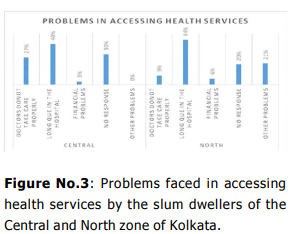 Problems faced by the slum dwellers in
Problems faced by the slum dwellers in
accessing health services
Figure No. 3 shows the various problems faced by the slum dwellers from the slums of Kolkata while accessing health services from both government and private health sectors. The problems faced by the slum dwellers are 40% of them had to stand in a long queue for several hours for accessing health services from the hospitals, followed by 27% reported that the doctors not taking care of the patients properly, 3% of them reported of financial problems (especially accessing health services from private sectors and 30% of them did not report any such problems faced in accessing health services. Similarly, in the slums of the north zone, as the figure no highlights that 44% of the slum dwellers had to stand in a
long queue for several hours for accessing health services from the hospitals, and 9% of them reported that the doctors did not take care of the patients properly, 6% reported of several financial problems,21% reported other problems (like taking leave from their jobs to visit the health centre), and about 20% of them did not report any such problems faced in accessing health services.
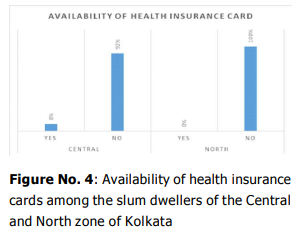 Availability of health insurance cards
Availability of health insurance cards
Figure No. 4 highlights the availability of health insurance cards among the slum dwellers of the slums of Kolkata. Therefore, it can be observed that in the central zone, 92% of the families do not have health
insurance cards while only 8% of them have health insurance cards. Similarly, in the north zone, as shown in the figure, highlights that none of the families have a health insurance card.
This secti on highl ights the status o f immunization and the availability of birth registration certificates among children in the slums of Kolkata. Data was collected from the families for the central zone, and figure no. 5 highlights that 74% of the children are immunized whereas 26% of the children are not immunized. Again, it can be observed from the figure that in the north zone, 86% of the children are immunized whereas only 14% of them are not immunized.
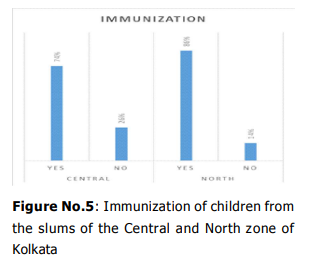 Followed by the availability of maternity
Followed by the availability of maternity
benefit scheme, that the central zone, as
figure no.8 highlights only 8% of the women
could avail of the maternity benefit scheme
rest 92% of these women did not avail benefit
from the maternity benefit scheme.
Furthermore, in the northern zone, 96% of
the women did not receive any maternity
benefit scheme while only 4% of them could
avail the benefit from the maternity benefit
scheme.
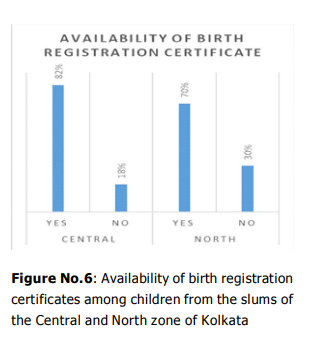 Several interviews with lactating mothers of
Several interviews with lactating mothers of
these slums reported the lack of awareness
of the importance of institutional delivery as
well as the availability of a maternity benefit
scheme. Inferences can be drawn that
institutional delivery is higher in the slums of
the central zone than in the northern zone.
But the majority of the women from the slums
of Kolkata did not avail of any maternity
benefit scheme. For the present study,
interviews with the women reflected that only
a few among them had the information they
utilized whereas a few of them did not utilize
it. They also reported that the procedure
involved in accessing the maternity benefit
scheme involves a long process which they
can hardly make through it.
Child Birth-Place of Delivery-Institutional or Home and Availability of Maternity benefit Scheme
Family welfare programmes are the most emphasized ones in India, and it was important to explore the availability of the services by these slum dwellers. Accordingly, data was collected related to the place of delivery and the availability of the maternity benefit scheme in the slums of Kolkata. Figure no.7 reveals that in the central zone, the percentage of hospital delivery is 68% while 32% had home delivery. Followed by the north zone, the percentage of hospital delivery is only 41%, whereas 59% of the women had home delivery of their children.
 Followed by the availability of maternity
benefit scheme, that the central zone, as
figure no.8 highlights only 8% of the women
could avail of the maternity benefit scheme
rest 92% of these women did not avail benefit
from the maternity benefit scheme.
Furthermore, in the northern zone, 96% of
the women did not receive any maternity
benefit scheme while only 4% of them could
avail the benefit from the maternity benefit
scheme.
Followed by the availability of maternity
benefit scheme, that the central zone, as
figure no.8 highlights only 8% of the women
could avail of the maternity benefit scheme
rest 92% of these women did not avail benefit
from the maternity benefit scheme.
Furthermore, in the northern zone, 96% of
the women did not receive any maternity
benefit scheme while only 4% of them could
avail the benefit from the maternity benefit
scheme. 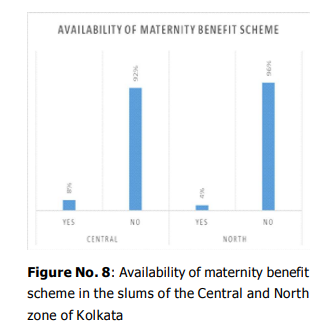 Several interviews with lactating mothers of
these slums reported the lack of awareness
of the importance of institutional delivery as
well as the availability of a maternity benefit
scheme. Inferences can be drawn that
institutional delivery is higher in the slums of
the central zone than in the northern zone.
But the majority of the women from the slums
of Kolkata did not avail of any maternity
benefit scheme. For the present study,
interviews with the women reflected that only
a few among them had the information they
utilized whereas a few of them did not utilize
it. They also reported that the procedure
involved in accessing the maternity benefit
scheme involves a long process which they
can hardly make through it.
Several interviews with lactating mothers of
these slums reported the lack of awareness
of the importance of institutional delivery as
well as the availability of a maternity benefit
scheme. Inferences can be drawn that
institutional delivery is higher in the slums of
the central zone than in the northern zone.
But the majority of the women from the slums
of Kolkata did not avail of any maternity
benefit scheme. For the present study,
interviews with the women reflected that only
a few among them had the information they
utilized whereas a few of them did not utilize
it. They also reported that the procedure
involved in accessing the maternity benefit
scheme involves a long process which they
can hardly make through it. Health is primarily a major challenge in slums due to poor environmental conditions, poor sanitation, drainage system etc. Hence, this filthy environment in the slums prohibits the slum dwellers to attain a better quality of life. The present study highlights the vulnerable physical location of the slums of Kolkata which are mainly situated near the major drain (nallah) and a railway track. Consequently, this filthy environment is a deterrent to the health condition of the slum dwellers as well as children. This leads to the onset of several diseases which are both communicable, noncommunicable as well as infectious among the slum dwellers due to the lack of several basic facilities of life and the filthy physical location of the slums. Hence, the deplorable condition of the slums with overcrowded settlements, dilapidated dwellings, and lack of other civic ameni ties highlig hts the unhealthy environment of the slums as the major reason for the high prevalence of the disease among inhabitants living in slums. This highlights that the families from the slums of Kolkata are susceptible to several diseases and as such spent a considerable amount of their income on their health issues increasing their expenditure.
CONCLUSION
REFERENCES
Role of funding source: None

ISSN: 2582-1393 (online)
UGC Care List Journal
